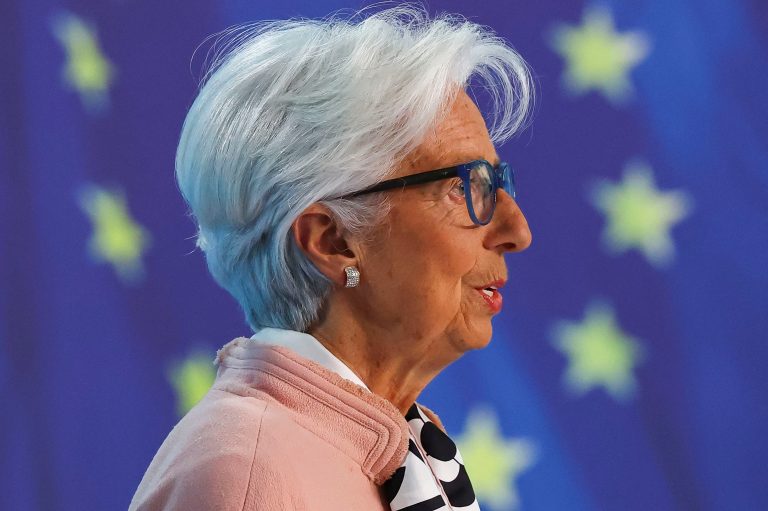🎧 Listen to This Article
As Christine Lagarde stepped to the podium at ECB headquarters in Frankfurt last Thursday, her tone was measured but unmistakably urgent: Europe is bracing for a perfect storm. With interest rates lowered for the sixth consecutive time—now at 2.25%—the European Central Bank has shifted from inflation control to full-scale economic defense. The reason? Washington.
Donald Trump’s renewed tariff campaign, cloaked in patriotic branding as “Liberation Day” levies, has injected heavy doses of uncertainty into global markets. While the headlines focus on the politics of protectionism, the real story lies deeper: in the shifting tectonics of global trade, monetary autonomy, and the future of the European economy.
From Inflation Fighter to Growth Defender
Until mid-2024, the ECB was fighting an entirely different battle—against post-pandemic inflation, which had exceeded targets across the eurozone. A gradual but steady decline toward the 2% benchmark seemed like a victory. But victory in one arena can expose vulnerability in another. The ECB’s pivot reflects how today’s economic battleground is no longer domestic prices, but international uncertainty.
Trump’s tariffs are not merely fiscal barriers; they are geopolitical chess moves that distort supply chains, unsettle business investment, and destabilize currency confidence. The ECB’s reaction—cutting rates despite inflation being “well on track”—signals that it views this trade war not as a side plot, but as the central economic threat of 2025.
A Monetary Policy Caught in Crossfire
Trade tariffs and monetary policy are strange bedfellows. Typically, trade disputes fall under the remit of fiscal authorities, but when tariffs cause uncertainty and crush confidence, central banks are forced to act.
Here’s why this matters globally:
- Currency Volatility:
Lower ECB rates make the euro less attractive, potentially offsetting US tariffs by weakening Europe’s export prices. But such a move risks provoking retaliatory currency actions from other economies, including China. - Capital Misallocation:
If interest rates are suppressed artificially to compensate for political shocks, capital can flee productive investments and chase speculative returns. Europe risks a repeat of the post-2008 “cheap money” distortions. - Erosion of Monetary Firepower:
With rates now near their lower bound, the ECB has little room left for maneuver. Any deeper shock—from energy volatility to another tariff escalation—would leave it reliant on unconventional tools or fiscal policy, which remains fragmented in the EU. - Global Policy Divergence:
The Fed, meanwhile, is signaling a hold or potential hikes if inflation persists. This divergence sets the stage for currency imbalances and greater global financial instability, especially for emerging markets caught between the euro and dollar.
What Should Happen Next: Policy Coordination, Not Policy Panic
The ECB cannot carry this burden alone. Interest rates are blunt tools for what is fundamentally a structural and geopolitical problem. What’s needed is a coordinated, proactive fiscal and trade policy alignment within the EU.
Here’s what that looks like:
- Strategic Trade Diplomacy:
The European Commission must not wait for retaliatory tariffs to be imposed. Instead, it should launch multilateral engagement with other economies hit by the US measures—especially China, South Korea, and Canada—to form a counterbalance of open markets. - Targeted Fiscal Expansion:
Germany’s new €100bn+ infrastructure and defense stimulus is a smart start. But the broader eurozone must match this with coordinated, productivity-focused spending to counteract trade drag and stimulate internal demand. - Pan-European Industrial Policy:
With Chinese goods potentially being diverted to Europe as US markets tighten, the EU must protect its manufacturing base not through tariffs, but through investment in automation, green energy, and advanced tech—creating a competitive, not protected, Europe.
A Dangerous Misreading of 2018
Some in the financial community are drawing comparisons between today’s tariffs and the Trump-era moves of 2018. But this is a flawed analogy. In 2018, global interest rates were rising, supply chains were intact, and Europe was recovering.
In 2025, the economic plate tectonics are more fragile. Supply chains remain brittle post-COVID, war-induced energy shocks have not fully stabilized, and political fragmentation within the EU threatens cohesive response strategies. The ECB’s rate cut is a lifeline—yes—but lifelines don’t float forever.
Monetary Policy as Geopolitical Armor
This rate cut may seem technical—a 25 basis point move in a well-worn cycle. But it reflects something deeper: central banks are becoming the first responders to global instability. Monetary policy is no longer just about inflation or growth; it’s now about shielding economies from political chaos.
Christine Lagarde’s message was clear: “We have to stand ready for the unpredictable.” For businesses, tax strategists, and policymakers alike, the question is no longer if uncertainty is the new normal—but how prepared we are to thrive within it.
For further details, clarification, contributions, or any concerns regarding this article, please contact us at editorial@tax.news. We value your feedback and are committed to providing accurate and timely information. Please note that our privacy policy will handle all inquiries



